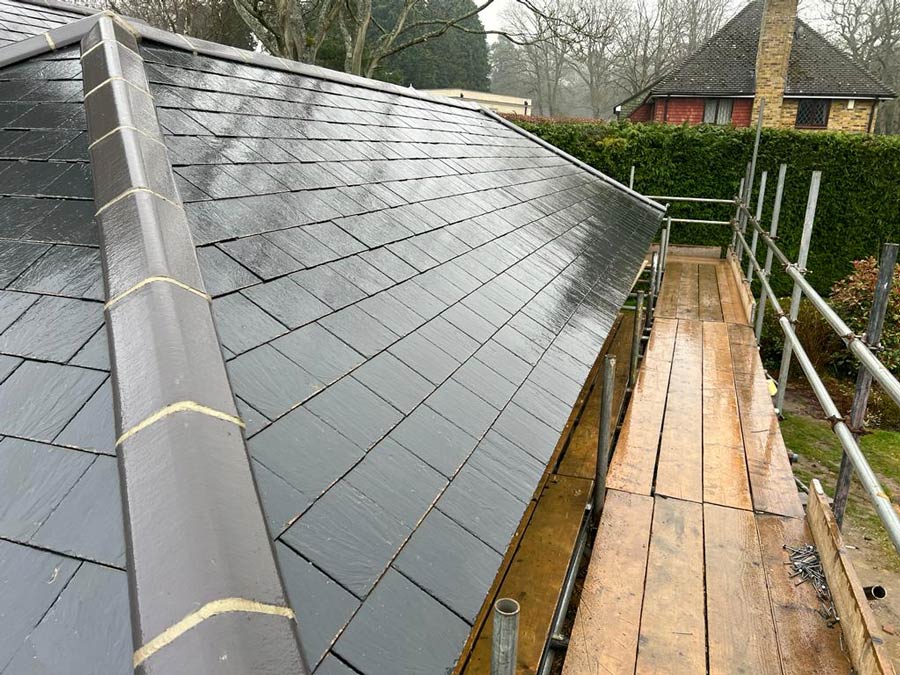When it comes to choosing a new roof for your home, it’s a big decision and it can be really confusing. There are lots of different factors to consider, including style, cost, and durability. One of the most popular options is the pitched roof – this features a sloping design with two or more sections that slope in opposite directions. Pitched roofs are a common sight across most of the UK, thanks to their classic look and range of different benefits (not to mention a loft for storage!). We’ve put together this guide to help you explore the pros and cons of pitched roofs and provide expert advice to help you make an informed decision.
Firstly, What is a Pitched Roof?
A pitched roof is a sloping roof that has two or more sections that slope in opposite directions. This type of roof is commonly used in residential homes and offers a range of benefits over flat roofs.
Pros of Pitched Roofs
1. Kerb Appeal
One of the most significant benefits of a pitched roof is its aesthetic ‘kerb’ appeal. Pitched roofs give a home a traditional, classic look, and they come in a variety of materials, colours, and designs to suit any style. Pitched roofs are often seen as a symbol of quality craftsmanship and attention to detail, which can add value to your home and make it stand out.
2. Increased Loft Space (lots of storage!)
Pitched roofs offer more loft space than flat roofs, which can be useful for storage or for converting into liveable space. With a pitched roof, you’ll have more headroom and space to move around, which can make the loft a more functional part of your home – an all important feature when space is at a premium.
3. Better Drainage
One of the most important benefits of a pitched roof is its ability to channel rainwater away from the roof. This prevents pooling and potential water damage to the structure of your home. Pitched roofs are designed to shed water quickly, which helps prevent leaks and other problems associated with water damage. This means you’ll have fewer maintenance issues to worry about and a longer lifespan for your roof.
4. Longer Lifespan
Pitched roofs generally have a longer lifespan than flat roofs, thanks to their sturdier design and better drainage. With proper maintenance, a pitched roof can last for decades. This means you’ll have a more durable and reliable roof that requires less upkeep and repair over time. At Banks Roofing, we’ve been the trusted company for roofing in Woking for many years.
Cons of Pitched Roofs
1. Higher Cost
One of the main disadvantages of a pitched roof is it’s typically a higher cost. Pitched roofs can be more expensive to install than flat roofs, due to the additional materials and labour required. The steeper the pitch of the roof, the more materials and labor will be needed, which can add to the overall cost. It’s important to keep in mind that the long-term benefits of a pitched roof may outweigh the initial cost.
2. More Maintenance
Pitched roofs require more maintenance than flat roofs, due to the need to keep the gutters and valleys clean and free of debris. This can be especially challenging if your home is located in an area with a lot of trees or other debris. The good news is that there are plenty of businesses who are able to offer basic maintenance and upkeep for you, so you don’t need to worry about getting up on a ladder! Keeping your pitched roof well-maintained is essential for preventing water damage and other issues over time, so make sure you don’t ignore it.
3. More Challenging Installation
When it comes to installing a pitch roof, another downside is that it requires more skill and experience to install than a flat roof. This can increase the cost and potential for errors during installation. The steeper the pitch of the roof, the more challenging the installation process will be, which can lead to more time and labour required. The best way to get an idea on price for a pitched roof is to give us a call.
4. Less Accessible
Pitched roofs are less accessible than flat roofs, making it more difficult for maintenance and repair work. If your roof requires repair or maintenance, it may be challenging for contractors to access certain parts of the roof, especially if it has a steep pitch. This could increase costs and time required for maintenance and repairs, which can be inconvenient and disruptive for homeowners. If a pitched roof is built well and kept maintained, it should last for many years.
Conclusion
Pitched roofs are usually a great option when choosing a new roof for your home. That being said, there are some disadvantages to consider. By understanding the pros and cons of pitched roofs, you can make an informed decision that fits your needs and budget. At Banks Roofing Surrey & Hampshire, we have years of experience installing, maintaining, and repairing pitched roofs. We understand the importance of choosing the right roof for your home and are committed to providing expert advice and quality service to our customers.
If you’re considering a new roof for your home, contact us today to discuss your options and get a free quote. We’ll work with you to choose the right roofing material and design for your needs and budget, ensuring that you have a reliable and durable roof that protects your home and adds value to your property.



